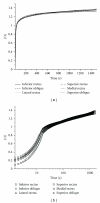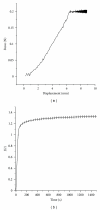Creep behavior of passive bovine extraocular muscle
- PMID: 22131809
- PMCID: PMC3216464
- DOI: 10.1155/2011/526705
Creep behavior of passive bovine extraocular muscle
Abstract
This paper characterized bovine extraocular muscles (EOMs) using creep, which represents long-term stretching induced by a constant force. After preliminary optimization of testing conditions, 20 fresh EOM samples were subjected to four different loading rates of 1.67, 3.33, 8.33, and 16.67%/s, after which creep was observed for 1,500 s. A published quasilinear viscoelastic (QLV) relaxation function was transformed to a creep function that was compared with data. Repeatable creep was observed for each loading rate and was similar among all six anatomical EOMs. The mean creep coefficient after 1,500 seconds for a wide range of initial loading rates was at 1.37 ± 0.03 (standard deviation, SD). The creep function derived from the relaxation-based QLV model agreed with observed creep to within 2.7% following 16.67%/s ramp loading. Measured creep agrees closely with a derived QLV model of EOM relaxation, validating a previous QLV model for characterization of EOM biomechanics.
Figures




Similar articles
-
Viscoelastic characterization of extraocular Z-myotomy.Invest Ophthalmol Vis Sci. 2014 Dec 4;56(1):243-51. doi: 10.1167/iovs.14-15510. Invest Ophthalmol Vis Sci. 2014. PMID: 25477318 Free PMC article.
-
Quasilinear viscoelastic behavior of bovine extraocular muscle tissue.Invest Ophthalmol Vis Sci. 2009 Aug;50(8):3721-8. doi: 10.1167/iovs.08-3245. Epub 2009 Apr 8. Invest Ophthalmol Vis Sci. 2009. PMID: 19357357 Free PMC article.
-
Independent passive mechanical behavior of bovine extraocular muscle compartments.Invest Ophthalmol Vis Sci. 2012 Dec 19;53(13):8414-23. doi: 10.1167/iovs.12-10318. Invest Ophthalmol Vis Sci. 2012. PMID: 23188730 Free PMC article.
-
Compartmentalization of extraocular muscle function.Eye (Lond). 2015 Feb;29(2):157-62. doi: 10.1038/eye.2014.246. Epub 2014 Oct 24. Eye (Lond). 2015. PMID: 25341434 Free PMC article. Review.
-
Palisade endings and proprioception in extraocular muscles: a comparison with skeletal muscles.Biol Cybern. 2012 Dec;106(11-12):643-55. doi: 10.1007/s00422-012-0519-1. Epub 2012 Oct 10. Biol Cybern. 2012. PMID: 23053430 Review.
Cited by
-
Determination of poisson ratio of bovine extraocular muscle by computed X-ray tomography.Biomed Res Int. 2013;2013:197479. doi: 10.1155/2013/197479. Epub 2012 Dec 30. Biomed Res Int. 2013. PMID: 23484091 Free PMC article.
-
Tensile properties of glaucomatous human sclera, optic nerve, and optic nerve sheath.Biomech Model Mechanobiol. 2024 Dec;23(6):1851-1862. doi: 10.1007/s10237-024-01872-0. Epub 2024 Aug 8. Biomech Model Mechanobiol. 2024. PMID: 39112729 Free PMC article.
-
Biomechanics of superior oblique Z-tenotomy.J AAPOS. 2013 Dec;17(6):612-7. doi: 10.1016/j.jaapos.2013.09.004. J AAPOS. 2013. PMID: 24321425 Free PMC article.
-
Atomic force microscopy determination of Young׳s modulus of bovine extra-ocular tendon fiber bundles.J Biomech. 2014 Jun 3;47(8):1899-903. doi: 10.1016/j.jbiomech.2014.02.011. Epub 2014 Feb 14. J Biomech. 2014. PMID: 24767704 Free PMC article.
-
Viscoelastic characterization of extraocular Z-myotomy.Invest Ophthalmol Vis Sci. 2014 Dec 4;56(1):243-51. doi: 10.1167/iovs.14-15510. Invest Ophthalmol Vis Sci. 2014. PMID: 25477318 Free PMC article.
References
-
- Robinson DA, O’Meara DM, Scott AB, Collins CC. Mechanical components of human eye movements. Journal of Applied Physiology. 1969;26(5):548–553. - PubMed
-
- Collins CC, Carlson MR, Scott AB, Jampolsky A. Extraocular muscle forces in normal human subjects. Investigative Ophthalmology and Visual Science. 1981;20(5):652–664. - PubMed
-
- Simonsz HJ. Force-length recording of eye muscles during local anesthesia surgery in 32 strabismus patients. Strabismus. 1994;2(4):197–218. - PubMed
-
- Fung YC. Biomechanics: Mechanical Properties of Living Tissues. New York, NY, USA: Springer; 1993.
Publication types
MeSH terms
Grants and funding
LinkOut - more resources
Full Text Sources

